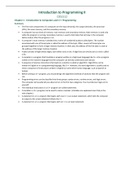Summary
COS1512 SUMMARY OF CHAPTERS 1, 4-6, 8-12, 14-15 and 17
- Course
- Institution
- Book
This summary has Chapters 1, 4-6, 8-12, 14-15 and 17. This reduced the pages from 606 to 52. These notes are made for me to study for my exam so you can trust that this is for people who are getting this upcoming exam.
[Show more]



